一、散點圖stripplot( ) 與swarmplot()
1.分類散點圖stripplot( )?
用法stripplot(x=None, y=None, hue=None, data=None, order=None, hue_order=None,jitter=True, dodge=False, orient=None,
? color=None, palette=None,size=5, edgecolor="gray", linewidth=0, ax=None, **kwargs)
- x,y 分類字段和分布統計字段
- hue 在x分類的基礎上進行二次分類的字段
- data 源數據
- order 圖表中顯示的分類
- jitter?當點數據重合較多時用該參數做一些調整,可以設置為True或者間距0.1,否則會有重合的點
- dodge 如果有二次分類,二次分類是否拆分顯示
tips = sns.load_dataset("tips") #導入系統數據 print(tips.head()) print(tips['day'].value_counts())


total_bill tip sex smoker day time size 0 16.99 1.01 Female No Sun Dinner 2 1 10.34 1.66 Male No Sun Dinner 3 2 21.01 3.50 Male No Sun Dinner 3 3 23.68 3.31 Male No Sun Dinner 2 4 24.59 3.61 Female No Sun Dinner 4 Sat 87 Sun 76 Thur 62 Fri 19 Name: day, dtype: int64
?
fig = plt.figure(figsize=(15,10)) ax1 = plt.subplot(221) # 對data數據按day分類,統計total_bill的分布,如果點重合較多適當顯示開 sns.stripplot(x="day", y="total_bill", data=tips, jitter = True, size = 5, edgecolor = 'w',linewidth=1, marker = 'o', ax=ax1)ax2 = plt.subplot(222) # 對data數據按day分類,統計total_bill的分布,并且圖表中只顯示按day分類的中的Sat和Sun sns.stripplot(x="day", y="total_bill", data=tips,jitter = True, order = ['Sat','Sun'],ax=ax2) ax3 = plt.subplot(223) # 對data數據按sex分類后再按day分類,統計total_bill的分布 sns.stripplot(x="sex", y="total_bill", hue="day",data=tips, jitter=True,ax = ax3)ax4 = plt.subplot(224) # 對data數據按sex分類后再按day分類,統計total_bill的分布,并且不同的day拆分顯示 sns.stripplot(x="sex", y="total_bill", hue="day",data=tips, jitter=True,palette="Set2",dodge=True,ax=ax4)
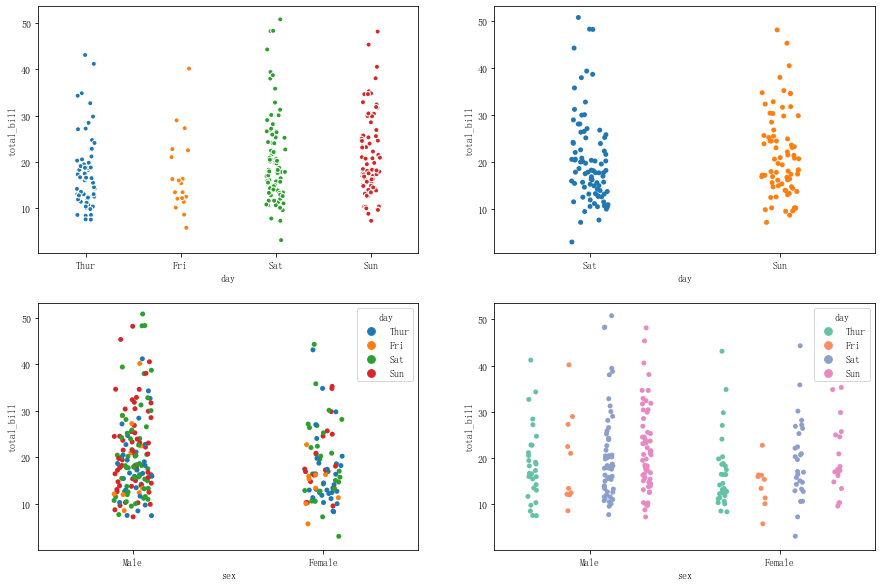
2.分簇散點圖swarmplot()
用法swarmplot(x=None, y=None, hue=None, data=None, order=None, hue_order=None,dodge=False, orient=None, color=None,
? ? ? ? ? ? ? ? ? ? ? palette=None,size=5, edgecolor="gray", linewidth=0, ax=None, **kwargs)
swarmplot()除了沒有jitter參數,其他用法類似stripplot()。
fig = plt.figure(figsize=(20,5)) ax1 = plt.subplot(141) # 對data數據按day分類,統計total_bill的分布,如果點重合較多適當顯示開 sns.swarmplot(x="day", y="total_bill", data=tips, size = 5, edgecolor = 'w',linewidth=1, marker = 'o', ax=ax1)ax2 = plt.subplot(142) # 對data數據按day分類,統計total_bill的分布,并且圖表中只顯示按day分類的中的Sat和Sun sns.swarmplot(x="day", y="total_bill", data=tips, order = ['Sat','Sun'],ax=ax2) ax3 = plt.subplot(143) # 對data數據按sex分類后再按day分類,統計total_bill的分布 sns.swarmplot(x="sex", y="total_bill", hue="day",data=tips, ax = ax3)ax4 = plt.subplot(144) # 對data數據按sex分類后再按day分類,統計total_bill的分布,并且不同的day拆分顯示 sns.swarmplot(x="sex", y="total_bill", hue="day",data=tips, palette="Set2",dodge=True,ax=ax4)

二、箱型圖boxplot()
boxplot(x=None, y=None, hue=None, data=None, order=None, hue_order=None,orient=None, color=None, palette=None,
? ? ? ? ? ? ?saturation=.75,width=.8, dodge=True, fliersize=5, linewidth=None,whis=1.5, notch=False, ax=None, **kwargs)
- x,y 分類字段和分布統計字段
- hue 在x分類的基礎上進行二次分類的字段
- data 源數據
- order 圖表中顯示的分類
- dodge 如果有二次分類,二次分類是否拆分顯示
- width 箱的間隔的比例,值越大間隔越小
- filtersize? 異常點大小
- whis 設置IQR
- notch 是否以中值做凹槽
fig = plt.figure(figsize=(12,5))ax1 = plt.subplot(121) sns.boxplot(x="day", y="total_bill", data=tips,linewidth = 2, width = 0.8, fliersize = 10, palette = 'hls', whis = 1.5, notch = True ) sns.swarmplot(x="day", y="total_bill", data=tips,color ='g',size = 3,alpha = 0.8) #在箱型圖上做分簇散點圖 ax2 = plt.subplot(122) sns.boxplot(x="day", y="total_bill", data=tips, hue = 'smoker', order = ['Sat','Sun'],palette = 'Reds') #根據day分類,再根據smkker分類

三、小提琴圖violinplot()
violinplot(x=None, y=None, hue=None, data=None, order=None, hue_order=None,bw="scott", cut=2,
? ? ? ? ? ? ? ?scale="area", scale_hue=True,?gridsize=100, width=.8,?inner="box", split=False, dodge=True,
? ? ? ? ? ? ? ?orient=None,linewidth=None, color=None, palette=None,?saturation=.75,ax=None, **kwargs)
- x,y 分類字段和分布統計字段
- hue 在x分類的基礎上進行二次分類的字段
- data 源數據
- order 圖表中顯示的分類
- dodge 如果有二次分類,二次分類的多個小提琴位置是否錯開,默認為True,False則多個小提琴會重復? (dodge=True與split=False效果相同)
- split?如果有二次分類,二次分類是否拆分整個提琴,默認為False顯示為多個獨立的小提琴,True則顯示為一個小提琴,左右兩側表示二次分類
- scale = 'area' 設置小提琴圖的寬度,area-保持小提琴面積相同,count-按照樣本數量決定寬度,width-寬度一樣
- gridsize = 100 設置小提琴圖邊線的平滑度,越高越平滑
- inner = 'box' 設置內部顯示類型 → “box”箱型圖, “quartile”分位數, “point”點, “stick”, None
- bw = 0.8 # 控制擬合程度,'scott'、'silverman'或者一個浮點數,一般可以不設置
fig = plt.figure(figsize=(20,5))ax1 = plt.subplot(141) sns.violinplot(x="day",y="total_bill",data=tips,linewidth=2,width=0.8,palette='hls',scale= 'area',gridsize=50,inner='box') ax2 = plt.subplot(142) sns.violinplot(x="day",y="total_bill",data=tips,hue = 'smoker',palette="muted",dodge=False,inner="point")#二次分類小提琴位置不錯開 ax3 = plt.subplot(143) sns.violinplot(x="day",y="total_bill",data=tips,hue = 'smoker',palette="muted",split=False,inner="stick")#二次分類不拆分小提琴,顯示為多個獨立小提琴 ax4 = plt.subplot(144) sns.violinplot(x="day",y="total_bill",data=tips,hue = 'smoker',palette="muted",split=True,inner="quartile")#二次分類拆分小提琴,左右兩側分別表示二次
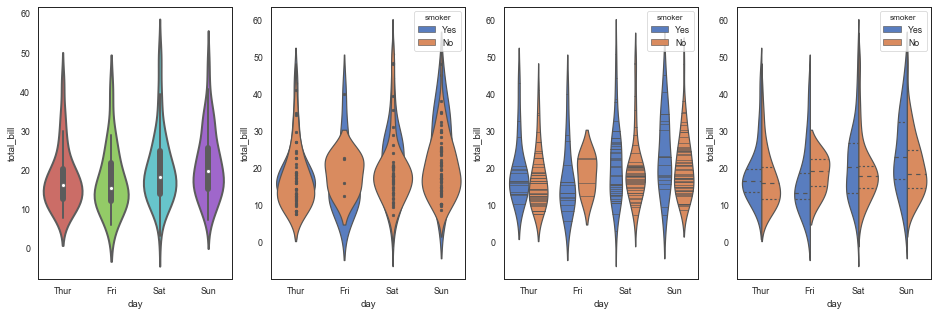
小提琴圖與分簇散點圖結合sns.violinplot()+ sns.swarmplot()
sns.violinplot(x="day", y="total_bill", data=tips, palette = 'hls',alpha=0.5, inner = None) sns.swarmplot(x="day", y="total_bill", data=tips, color="w")
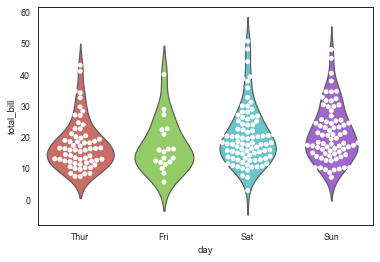
四、增強箱圖boxenplot()
boxenplot(x=None, y=None, hue=None, data=None, order=None, hue_order=None,orient=None, color=None,
? ? ? ? ? ? ? ? palette=None, saturation=.75,width=.8,dodge=True, k_depth='proportion', linewidth=None,
? ? ? ? ? ? ? ? scale='exponential', outlier_prop=None, ax=None, **kwargs)
(lv圖表使用boxenplot(),lvplot()即將被遺棄)
- x,y 分類字段和分布統計字段
- hue 在x分類的基礎上進行二次分類的字段
- data 源數據
- order 圖表中顯示的分類
- dodge 如果有二次分類,二次分類的多個小提琴位置是否錯開,默認為True,False則多個小提琴會重復? (dodge=True與split=False效果相同)
- scale = 'area' 設置lv圖的寬度,“linear”、“exonential”、“area”? ?(一般scale和k_depth保持默認就好)
- k_depth = 'proportion', # 設置框的數量 → “proportion”、“tukey”、“trustworthy”
- width 箱之間間隔
sns.lvplot(x="day", y="total_bill", data=tips, palette="mako", width = 0.8, scale = 'area',k_depth = 'proportion') sns.swarmplot(x="day", y="total_bill", data=tips, color ='k',size = 5)

五、柱狀圖barplot()?
seaborn中的柱狀圖不是單純的表示數量,而是表示了一個統計標準和對應的置信區間。
barplot(x=None, y=None, hue=None, data=None, order=None, hue_order=None,estimator=np.mean, ci=95,?
? ? ? ? ? ?n_boot=1000, units=None,orient=None, color=None, palette=None, saturation=.75,errcolor=".26",?
? ? ? ? ? ?errwidth=None, capsize=None, dodge=True,ax=None, **kwargs)
- x,y 分類字段和分布統計字段
- hue 在x分類的基礎上進行二次分類的字段
- data 源數據
- order 圖表中顯示的分類
- estimater 柱狀圖表示的統計量,默認和常使用均值
- ci 置信區間的誤差,0-100之內、或sd標準差,或None,默認為95
- saturation 顏色飽和度
- errcolor與errwidth 誤差線顏色與寬度
- capsize 誤差線延長寬度
- dodge 如果有二次分類,二次分類的多個多個柱狀圖位置是否錯開
- edgecolor 柱子的邊框顏色
#導入泰坦尼克號、小費和汽車事故的3個表的數據結構,在不同窗口顯示前5行 titanic = sns.load_dataset("titanic") titanic.head() tips = sns.load_dataset('tips') # tips.head() crashes = sns.load_dataset("car_crashes")# crashes.head()
?

? ??
??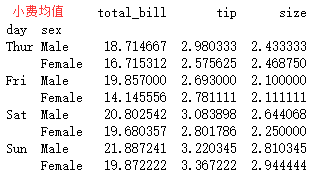 ? ?
? ?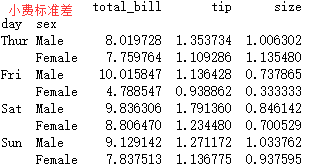

?
fig = plt.figure(figsize=(15,4)) ax1 = plt.subplot(131) #泰坦尼克,在性別分類的基礎上再按艙級別分類,統計生還率 sns.barplot(x="sex",y="survived",hue="class",data=titanic,palette = 'hls',capsize = 0.05,saturation=.8,errcolor = 'gray',errwidth = 2,ci = 'sd') ax2 = plt.subplot(132) #小費,在日期分類的基礎上再按性別分類,統計給的小費,置信區間的誤差為標準差 sns.barplot(x="day", y="total_bill", hue="sex", data=tips,edgecolor = 'white',errcolor='gray',capsize=0.1,ci='sd') ax3 = plt.subplot(133) #小費,同上,置信區間的誤差為默認的95 sns.barplot(x="day", y="total_bill", hue="sex", data=tips,edgecolor = 'white',errcolor='gray',capsize=0.1)

crashes = sns.load_dataset("car_crashes").sort_values("total", ascending=False) f,ax = plt.subplots(figsize=(8, 20))# 創建圖表 sns.set_color_codes("pastel") sns.barplot(x="total", y="abbrev", data=crashes,label="Total", color='b',edgecolor = 'w')# 設置第一個柱狀圖 sns.set_color_codes("muted") sns.barplot(x="alcohol", y="abbrev", data=crashes, label="Alcohol-involved",color='b',edgecolor = 'w')# 設置第二個柱狀圖 ax.legend(ncol=2, loc="lower right") sns.despine(left=True, bottom=True)
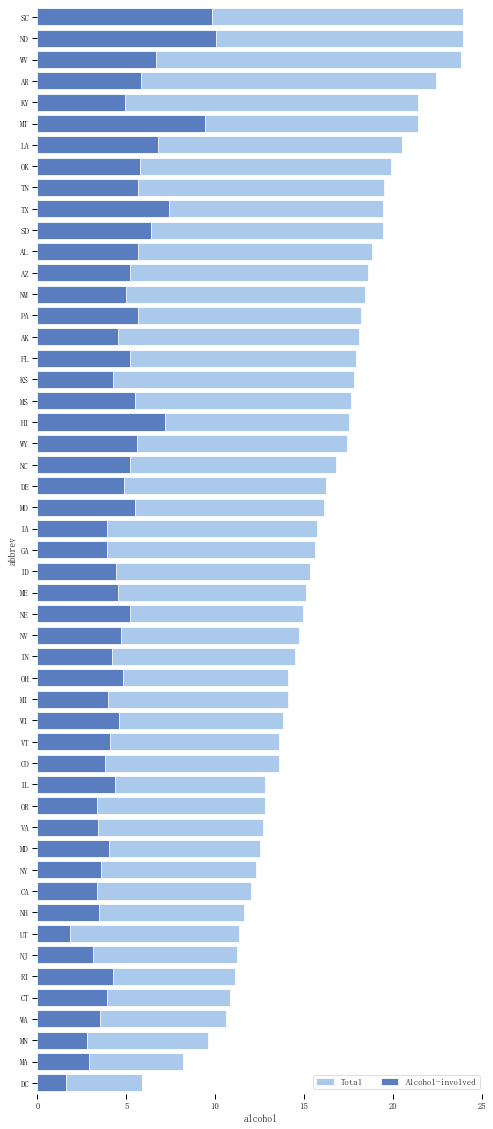
六、計數柱狀圖countplot()?
countplot(x=None, y=None, hue=None, data=None, order=None, hue_order=None,orient=None, color=None,
? ? ? ? ? ? ? ? palette=None, saturation=.75,dodge=True, ax=None, **kwargs)
- x,y 同時表示分類字段和顯示方向,即在x軸上或在y軸上對指定的字段進行計數顯示
- hue 在x分類或者y分類的基礎上進行二次分類的字段
- data 源數據
- order 圖表中顯示的分類
- dodge 如果有二次分類,二次分類的多個多個柱狀圖位置是否錯開
- edgecolor 柱子的邊框顏色
fig = plt.figure(figsize=(12,4)) ax1 = plt.subplot(121) sns.countplot(x="day", hue="sex", data=tips, palette = 'muted') #豎直顯示,在日期分類的基礎上再按性別分類 ax2 = plt.subplot(122) sns.countplot(y="day", hue="sex", data=tips, palette = 'muted') #水平顯示
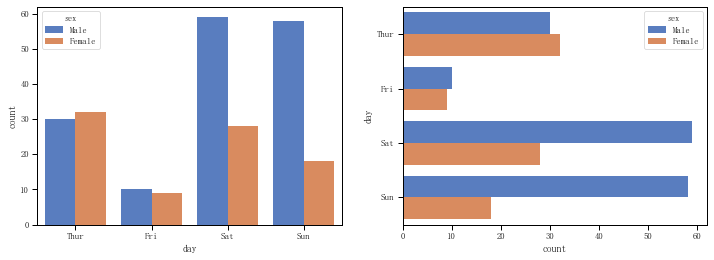
七、折線圖pointbar()
折線圖pointbar()和barplot()的用法類似,只是barplot()用柱狀圖表示均值,而pointbar()用一個點表示了均值。
pointplot(x=None, y=None, hue=None, data=None, order=None, hue_order=None,estimator=np.mean, ci=95,
? ? ? ? ? ? ? n_boot=1000, units=None,markers="o", linestyles="-", dodge=False, join=True, scale=1,
? ? ? ? ? ? ? orient=None, color=None, palette=None, errwidth=None,capsize=None, ax=None, **kwargs)
- x,y 分類字段和分布統計字段
- hue 在x分類的基礎上進行二次分類的字段
- data 源數據
- order 圖表中顯示的分類
- estimater 柱狀圖表示的統計量,默認和常使用均值
- ci 置信區間的誤差,0-100之內、或sd標準差,或None,默認為95
- marker 均值的表示形式
- errwidth 誤差線顏色與寬度
- capsize 誤差線延長寬度
- dodge 如果有二次分類,二次分類的多個線是否分開
- joint 是否連線
sns.pointplot(x="day",y="total_bill",hue = 'sex',data=tips,palette = 'hls',dodge = True,join = True,markers=["o", "x"],linestyles=["-", "--"]) tips.groupby(['day','sex']).mean()['total_bill']
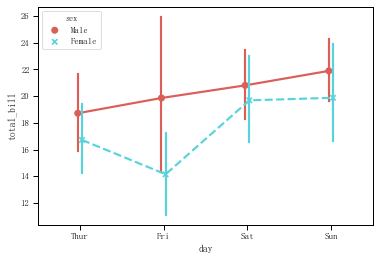
?




)






的高級可視化)


——fabric-sdk-java應用)




)